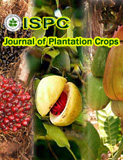Integrated nutrient management in turmeric (Curcuma longa L.) cv. GNT-2
DOI:
https://doi.org/10.25081/jpc.2023.v51.i3.8859Abstract
The present experiment was carried out, with a view to study the “Integrated nutrient management in turmeric (Curcuma longa L.) cv. GNT-2” during kharif season of the year 2021-22 at Regional Horticultural Research Station, ASPEE College of Horticulture and Forestry, Navsari Agricultural University, Navsari, Gujarat, India. The experiment was conducted in randomized block design (RBD) which included ten treatments and three replications consisting viz., T1: RDF (FYM @ 20 t/ha + 60:60:60 NPK kg/ha), T2: FYM 15 t/ha + 75 % RDF, T3: FYM 20 t/ha + 50 % RDF, T4: Vermicompost 10 t/ha + 75 % RDF, T5: Vermicompost 15 t/ha + 50 % RDF, T6: Bio-compost 10 t/ha + 75 % RDF, T7: Bio-compost 15 t/ha + 50 % RDF, T8: FYM 15 t/ha + 50 % RDF + Novel organic liquid nutrients 5 %, T9: Vermicompost 10 t/ha + 50 % RDF + Novel organic liquid nutrients 5 % and T10: Bio-compost 10 t/ha + 50 % RDF + Novel organic liquid nutrients 5 %. The results revealed that growth parameters i.e. plant height (29.71 cm), number of leaves (5.20), length of leaf (25.15 cm) and breadth of leaf (10.39 cm) were recorded maximum at 45 days after planting when the plots are treated with T1: RDF (FYM @ 20 t/ha + 60:60:60 NPK kg/ha). Among the all treatments, application of FYM 15 t/ha + 50 % RDF + Novel organic liquid nutrients 5 % (T8) gave the maximum plant height (62.78 cm, 130.13 cm and 135.47 cm), number of tillers per plant (1.60, 3.43 and 5.22), number of leaves per plant (7.08, 9.77 and 12.27), length of leaf (32.65 cm, 58.50 cm and 81.21 cm) and breadth of leaf (12.13 cm, 14.44 cm and 18.09 cm) at 75, 135 and 195 DAP, respectively.In case of yield and yield attributes, the maximum number of mother rhizomes per plant (3.54), number of fingers rhizomes per plant (18.57), weight of mother rhizomes (53.26 g per plant) and fresh rhizomes yield (317.80 g per plant and 34.26 t per ha) were observed under the application of FYM 15 t/ha + 50 % RDF + Novel organic liquid nutrients 5 % (T8). Quality aspects viz., curcumin content (4.93 %) and essential oil (3.67 %) were found significantly higher in T9 (Vermicompost 10 t/ha + 50 % RDF + Novel organic liquid nutrients 5 %). Regarding economics, the highest benefit cost ratio (3.77) and the maximum net realization (Rs.6,76,970/ha) was obtained under FYM 15 t/ha + 50 % RDF + Novel organic liquid nutrients 5 % (T8). Moreover, application of FYM 20 t/ha+ 50 % RDF (T3) improved the soil nutrient status.
Downloads
References
Amala, D., Prabhakar, B. N., Padma, M. and Triveni, S. 2019. Effect of integrated nutrient management on yield, yield attributing characters and economics of turmeric (Curcuma longa L.) var. IISR Pragath. The J. Res.,47(3): 51-54.
Anonymous 2021. “Horticulture Statistics at a Glance”. Horticulture Statistics Division, Department of Agriculture, Cooperation and Farmers Welfare, Ministry of Agriculture and Farmers Welfare, Government of India. p: 216.
Chawla, S. L., Roshni, A., Supal, D., Patel, M. A. and Pawar, R. D. 2018. Turfgrass research and development in India. Prog. Hort.,50(1/2): 64-69.
Jackson, M. L. 1973. “Soil Chemical Analysis”. Prentice - Hall of India (Pvt.) Ltd., New Delhi, India. 415 p.
Joy, P. P., Savithri, K. E., Mathew, S., Thomas, J. and Abraham, C. T. 2005. Effect of mulch and sources of nutrients on growth, yield and quality of black musli (Curculigoorchioides). Appl. Res. Med. Aromat. Plants, 27: 646-656.
Kadam, J. H. and Kamble, B. M. 2020. Effect of organic manures on growth, yield and quality of turmeric (Curcuma longa L.). J. Appl. Nat. Sci.,12(2): 91-97.
Kumar, K. R., Narasimha, S.R. and Kumar, N. R. 2016. Effect of organic and inorganic nutrient sources on growth,quality and yield of turmeric (Curcuma longa L.). Green Farming, 7(4): 889-892.
Kumar, Y. S. J., Kumar, M. R., Narayana, D. L. and Bhasker, K. 2021. Studies on effect of integrated nutrient management on growth of fennel (Foeniculum vulgare Mill.).J Pharm. Innov., 10(12): 2925-2928.
Manjunath, M. M., Sattigeri, V. V. and Mangraj, K. V. 1991. Curcumin in turmeric. Spice India,7(2): 7–9.
Nainwal, R. C., Singh, D., Katiyar, R. S., Sharma, L. and Tewari, S. K. (2015). Response of garlic to integrated nutrient management practices in a sodic soil of Uttar Pradesh, India. J. Spices Aromat.Crops,24(1): 33-36.
Nielson, R. A. 1965. Presence of plant growth substances in earth worms demonstrated by paper chromatography and the Went pea test . Nature,208(5015): 1113-1114.
Parikh, R. P. 2020. Effect of foliar application of organic liquid sources on growth, yield and quality of turmeric cv. GNT-2. Thesis, M.Sc. (Hort.) Navsari Agricultural University, Navsari, Gujarat. pp. 40-57.
Sharma, R. P., Naveen, D. and Chander, G. 2009. Effect of vermicompost, FYM and chemical fertilizers on yield, nutrient uptake and oil fertility in okra –onion sequence in wet temperate zone of Himachal Pradesh. J. Indian Soc. Soil Sci., 57(3):357-361.
Singhal, V., Patel, G. G., Patel, D. H., Kumar, U. and Saini, L. K. 2015. Effect of foliar application of water soluble fertilizers on growth, yield and economics of vegetable cowpea production. Int. Quart. J. Environ. Sci., 4: 79-83.
Yaduvanshi, N. P. S. 2001. Effect of five years of rice wheat cropping and NPK fertilizer use with and without organic and green manures on soil properties and crop yields in a reclamation sodic soil. J. Indian Soc. Soil Sci.,49(4): 714−719.
Published
How to Cite
Issue
Section
Copyright (c) 2024 Journal of Plantation Crops

This work is licensed under a Creative Commons Attribution 4.0 International License.







 .
.